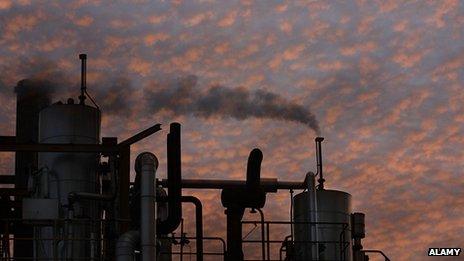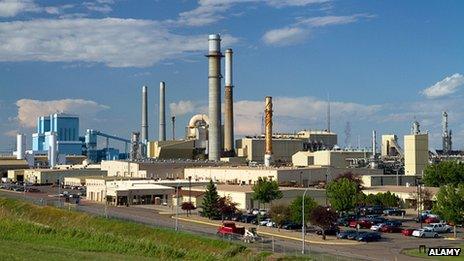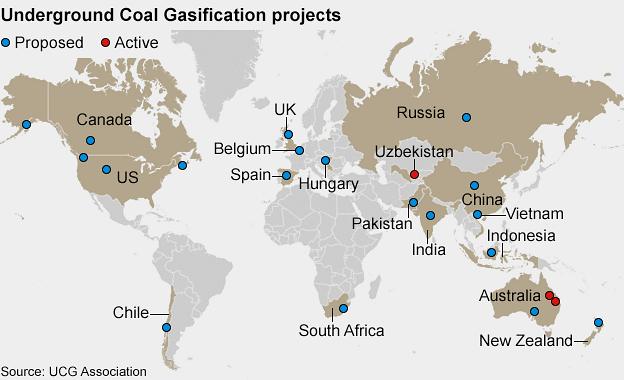Coal gasification: The clean energy of the future?
- Published

Turning coal into gas is not as environmentally friendly as it sounds
Dirty it may be, but coal is cheap.
For this simple reason, it remains the world's main source of power, providing a quarter of our primary energy and more than 40% of our electricity. And it will continue to do so for many years to come.
The challenge, then, is how to harness coal's energy more cleanly. While global attempts to develop carbon capture and storage (CCS) have stalled, a number of countries are looking at different ways to exploit their abundant coal reserves.
Not all are motivated by environmental concerns, but are driven instead by economics and a desire for energy independence.
Old and new
The main technology being used is coal gasification - instead of burning the fossil fuel, it is chemically transformed into synthetic natural gas (SNG).
The process is decades old, but recent rises in the price of gas mean it is now more economically viable. The US has dabbled in the technique, but China is going all out in a bid to satisfy its soaring demand for power and reduce its dependency on imported liquefied natural gas (LNG).
The country's National Energy Administration has laid out plans to produce 50 billion cubic metres of gas from coal by 2020, enough to satisfy more than 10% of China's total gas demand.

Not only does it make economic sense, but it allows China to exploit stranded coal deposits sitting thousands of kilometres from the country's main industrial centres. Transporting gas is, after all, a lot cheaper than transporting coal.
Coal gasification can also help address local pollution problems that have in recent months brought parts of the country to a virtual standstill.
But there are two big problems. First, coal gasification actually produces more CO2 than a traditional coal plant; so not only will China be using more coal, it will be doing so at a greater cost to the environment.
As Laszlo Varro, head of gas, coal and power markets at the International Energy Agency (IEA), says: "[Coal gasification] is attractive from an economic and energy security perspective.
"It can be a nice solution to local pollution, but its overall carbon intensity is worse [than coal mining], so it is not attractive at all from a climate change point of view".

The US has experimented with coal gasification in recent years
Indeed a study by Duke University in the US suggests synthetic natural gas emits seven times more greenhouse gases than natural gas, and almost twice as much carbon as a coal plant.
The second problem is water use. Coal gasification is one of the more water-intensive forms of energy production, and large areas of China, particularly in the western parts of the country that would host new gasification plants, already suffer from water shortages.
Mr Varro says a recent IEA report concluded that coal and coal gasification plants would use "quite a substantial portion of the available water in China".
Abundant reserves
Other countries are looking at different ways to get gas from coal. One method, particularly popular in Australia, is coal-bed methane, a process allowing access to coal deposits that are too deep to mine. Water is sucked out of the seam and the methane attached to the surface of the coal is freed and then collected.
China, Indonesia and Mozambique are looking at coal-bed methane, while the US and Canada also have abundant reserves.
Very little CO2 is emitted, but the process is not without controversy. Opponents highlight concerns about water contamination, land subsidence and disposing of waste water safely, while the water intensive process sometimes involves fracking.
And yet coal-bed methane has "fundamentally changed the dynamics of the gas industry in Australia," according to Phil Hirschhorn, partner at the Boston Consulting Group's energy practice in Sydney.
He says there are 200 trillion cubic feet of coal-bed methane resources in the country, with projects under construction to liquify and export 25 million tonnes of gas every year - equivalent to 10% of the entire global LNG market.
Clean access
A very different way to produce gas from coal is known as underground coal gasification (UCG), a process that has been around since the 19th Century but which has yet to become commercially viable on a grand scale - there is currently one working facility in Uzbekistan and pilot projects in Australia and South Africa.

Heavy pollution has forced China to rethink how it exploits its coal reserves
According to Julie Lauder, chief executive of the UCG Association, the process is a "new way of harnessing the energy of coal without the usual environmental impacts".
Technological developments and the rising price of gas mean UCG is now a feasible way of accessing the vast resources of coal that are too deep to mine, she says. Indeed, estimates suggest that as much as 85% of the world's coal resources cannot be accessed through traditional mining techniques.
Opening them up to exploitation has potentially disastrous implications for CO2 emissions and climate change, but the industry says these resources can be accessed cleanly.
The process involves pumping oxygen and steam through a small borehole into the coal seam to produce a small and controlled combustion. Unlike coal-bed methane, therefore, the actual coal is converted from a solid state into gas. The hydrogen, methane, carbon monoxide and CO2 are then siphoned off through a second borehole.
According to Dr Harry Bradbury, founder and chief executive of UK clean energy company Five Quarters, this process results in 20% of the CO2 produced from traditional coal mining.

But his company is developing a process that requires no burning of coal, and which combines what Dr Bradbury calls "solid state chemical engineering" with releasing gases that are trapped not just in the coal, but in the surrounding rocks as well. And all of this takes place offshore, relieving concerns about water contamination and subsidence, he argues.
But the real advantage lies in the ability to capture the CO2. "We need to get more radical - we need to get to zero carbon," Dr Bradbury says. "Full carbon capture and storage is absolutely crucial."
This can take place through re-injecting the CO2 back into the coal seams, or by converting the carbon into products such as plastics and graphene, he says.
The UK government has established a working party to investigate the merits of UCG, undoubtedly excited by the vast resources of coal sitting under the North Sea. Other governments are equally keen to exploit new technologies to access their hidden coal seams.
The problem, of course, is that the process depends entirely on wider efforts to develop CCS, efforts that have, so far, singularly failed to find a solution.
Until one is found, any attempts to gasify coal underground will either remain theoretical or will exacerbate the already grave problem of CO2 emissions. And if recent efforts are anything to go by, we could be waiting a long time.